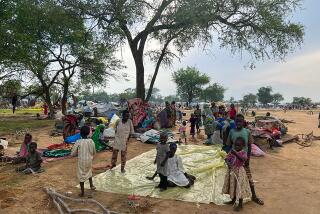Mixed Reaction Greets Lionsâ Return to Chad After War
KYABE, Chad â Frightened away by war, lions are returning to southern Chad now that the civil conflict has stopped. Environmentalists are delighted, but the villagers arenât.
The villagers say the lions are entering settled areas more frequently. Some have been seen on the outskirts of this small town, seat of the local sub-prefecture, where they have killed some sheep and cattle.
One villager said that the lions are difficult to detect because the high grass is yellow this time of year and camouflages them.
âThere can be several of them under a tree and you canât see them 20 meters away,â he said, adding that just two hours earlier he had killed a lion that came into his village.
All Wildlife Returning
Adjimbaye Guidinangar, chief forestry official in Kyabe, 435 miles southeast of NâDjamena, the capital, said that all species of wildlife are returning to the area.
Chad, one of the worldâs poorest countries, has been beset by two decades of civil war, most of it in the arid north, but also from time to time in the south, where the mainly Christian and animist population clashed with Muslims from the north.
As a result, keeping track of game has not been a priority and figures on wildlife population are difficult to come by.
Before the eruption of fighting in the south, a government report listed about 500 lions, 9,000 elephants and 3,500 buffalo in the nearby Zakouma National Park alone.
Soldiers Killed Animals
In 1979 and 1980, the years of the heaviest fighting, most of the game was driven away, in large part by soldiers who used heavy weapons, even cannons and rocket launchers, to kill the animals.
The fighters systematically slaughtered game for food but also to sell the meat, skins and ivory, which brought them their only income.
The lion population was reduced to nearly zero; elephants became rare, and other animals were either killed or fled into neighboring countries. In some areas, elephants and buffalo, very numerous in the past, nearly disappeared.
But since the fighting has ended in the fertile south, the animals are returning to their old habitats.
Attacks Reported
A report in September by the chief of the Singako canton noted that a group of lions had been âattacking animals and prowling day and night around the villages.â
âSeveral goats and a donkey have been carried away,â the report said.
No human deaths have been reported, but one army veteran said he was attacked by a lion while riding his horse near Kyabe. He said he felled it with his shotgun as it got ready to leap a second time at the horse. The lion was finished off by villagers with spears and sticks.
Another villager was bitten on the arm and leg and had to be hospitalized after an attack.
Herders Forced to Flee
Several dozen cattle, goats and donkeys have been reported eaten. On numerous occasions, herders have been forced to flee as lions approached.
In some villages, peasants have tried putting out poisoned sheep meat, but the lions have avoided it.
A report being prepared by forestry officials indicates that throughout the country there are now about 500 elephants, 300 lions and 700 buffalo.
The elephants, the officials say, are coming from northern Cameroon, where the population is dense and animals find the food scarce.
The lions in Chad are faced with an ecosystem that has not completely re-established itself, so they are turning to domestic animals for food.
Guidinangar said the return of the lions, although encouraging, also constitutes a serious obstacle to the re-establishment of other game in the Kyabe region.
More to Read
Sign up for Essential California
The most important California stories and recommendations in your inbox every morning.
You may occasionally receive promotional content from the Los Angeles Times.










